
01 Aug Designing For the Future – Illuminating the Possibilities and Trends
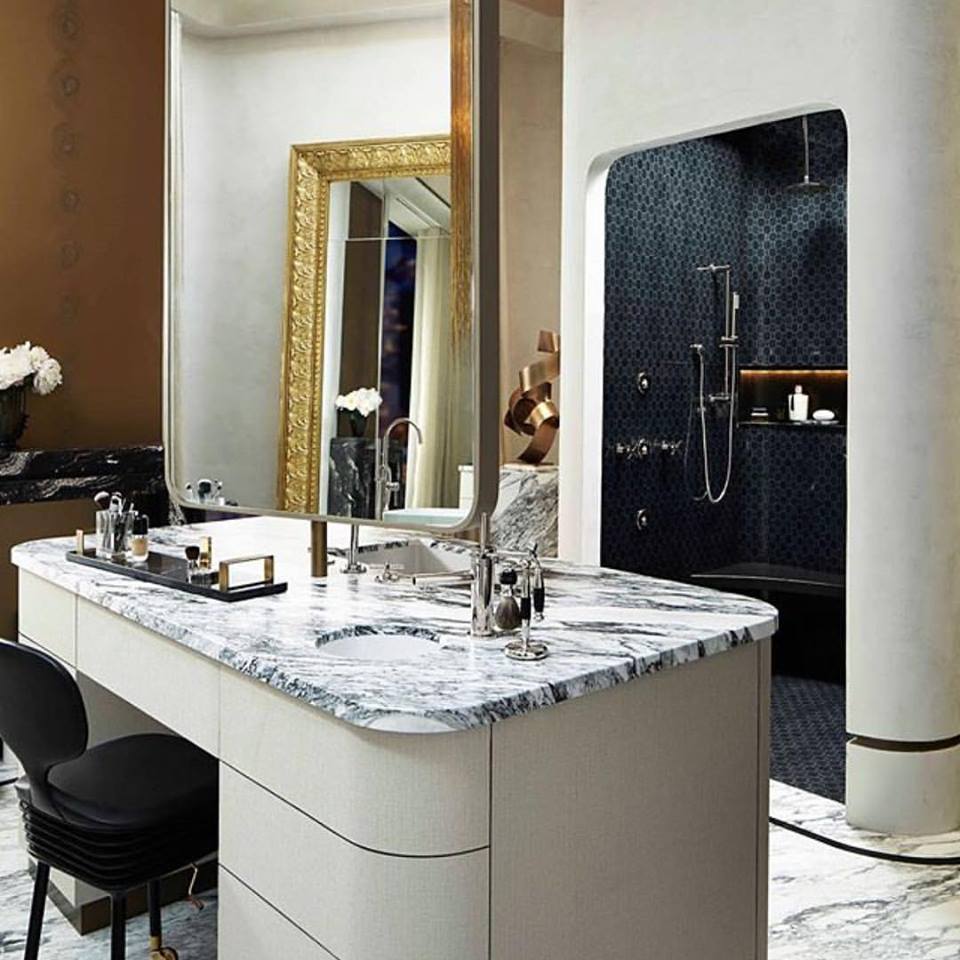
DXV contemporary penthouse by interior designer Alison Habermehl of Habermehl Design Group for the DXV 2017 Design Panel.
The possibilities are infinite! Designing for the future means many things to different people, cultures, generations, and diverse industries. From fashion to architecture, to manufacturing cars and homes, to what interior designers do every day – designing magnificent rooms with state of the art, high-quality products – our society is experiencing a rapid change in design that will continue into the future. How we respond to these changes will make all the difference!
I recently read an article that predicted there would be no personal cars, and instead we’d be calling car service companies like Fasten or Uber to take us where we want to go. Well, hang on a minute! While automation of the future may make handing over some tasks to perhaps electric cars, car services, or even driver-less cars for more efficiency, I still plan to personally drive my Subaru Outback on road trips to the beautiful mountains of West Texas and Colorado. Hopefully it will be an electric, fuel-efficient one in the near future, but none-the-less, some things will stay the same even in a rapidly changing world.
Color trends, fashion trends, and the next IT gadget – these trends come and go. Yet, each of us has our own individual taste and design aesthetic, so there will always be a need for traditional, modern, minimalism, and even maximalism in designing products and homes.
What is more significant is the underlying shift in the way we think about our world and design for it.
One important thing to remember: Design is not a trend, there is ALWAYS room for great design. It is the very foundation from which our lives emerge. Design is an element of the very quality and fabric of our daily lives that stays with us, even in a rapidly changing world.
However, one core value that won’t change is one of the most important components of the American Dream – home ownership. Be it a traditional house in a family-friendly neighborhood, a contemporary condo on the161st floor of the next tallest city skyscraper, a sprawling modern compound, or a quaint Tinyhome (a popular trend one could write a book on!), we have to live somewhere.
Two places stand out in the future of design for the home – the kitchen/living areas and the bedroom/bathrooms. We will still congregate, cook and socialize in our kitchens and living rooms, the heart of every home. And when it comes time to escape from a crazy busy week to relax and unwind, it is our bedroom and bathrooms, the cocoons of every home, where we will rejuvenate ourselves, fresh for another day to conquer the world. And that my friends, is a constant in our lives and will be even more critical in an increasingly complex world of evolving technology.
What will definitely change, is how we design our homes for the future and the choices we make in designing products that meet our needs of a rapidly aging population.
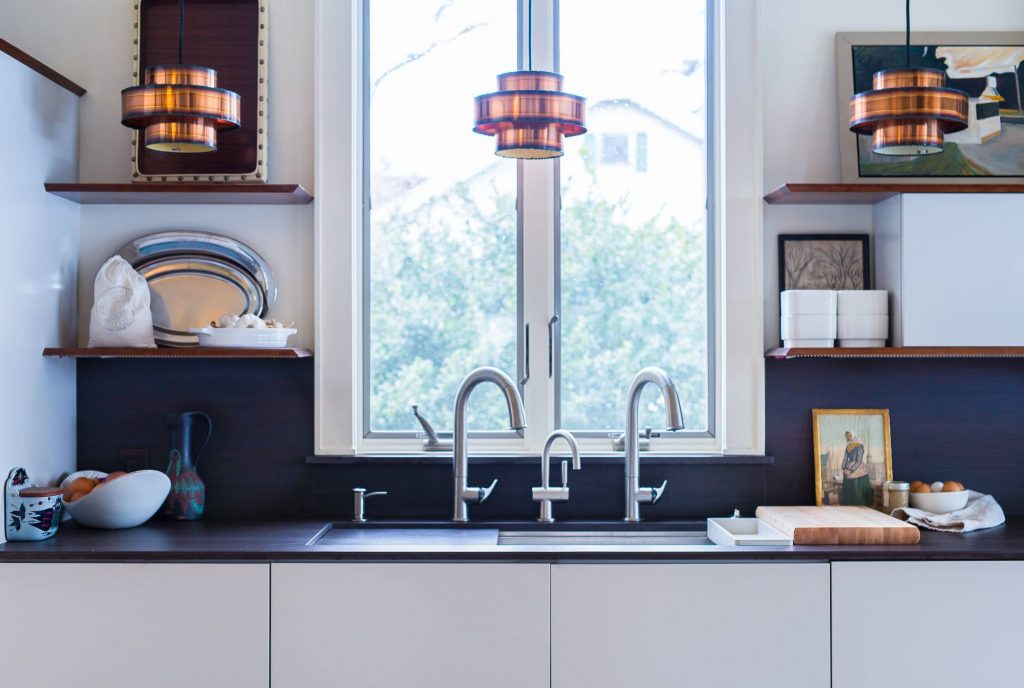
Kitchen by interior designer Susan Serra of Susan Serra Associates.
Here are four current design trends that I think will continue over the next 5 – 10 years.
- Designing for smart homes
- Designing with lighting innovation
- Designing more energy-efficient, environment-friendly products
- Designing with greater customization
One way I know this to be true is actually a joke in my family. You see, demographically, I am at the peak of the Baby Boomers, and whenever I decide to do something radically different, it coincidentally shows up in the local paper as a new shift or trend, and my husband and I always laugh about it. So when I hit 65, which is just 5 years off, what I will need in my home and how I choose to live my life with joy, happiness, safety and convenience will have a profound impact on design. Mark my words! 🙂
To give you a clearer picture of what these changes mean, I checked in with my home-industry, brand strategist, Guru friend Leslie Carothers, to get her perspective on what trends she sees coming that will drastically affect designing for the future. Named by Fixr.com as one of the Top 200 Influencers in the Home Design Industry 2017, Leslie Carothers is CEO of The Kaleidoscope Partnership + co-owner of Savour Partnership.
To keep up with Leslie like I do, please follow her on Twitter @tkpleslie. I am not surprised by what she says, but I see it is something important to consider in the world of design for all industries when designing for the future.
Leslie Carothers tracks “3 mega trends that will impact every aspect of the design/build industry.”
- “World population growth,
- Growth of major urban areas, and
- Growth of the world population over 60.”
According to Leslie: “By the year 2100, the UN estimates that the total world population will grow from 7.5 billion people now to 11.2 billion. The UN also estimates that mega-cities, cities with a population of over 10 million, will grow from the current 28 to 41 by the year 2030. In addition, by 2030, 56% of the world’s population will be over 60.”
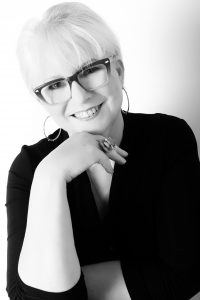
I asked her, with all that population growth, especially with an aging and more urban population, what opportunities does she see these trends creating for the design industry?
“First, there are tremendous opportunities in providing solutions to the ways people can live in smaller homes without sacrificing function, comfort, beauty, privacy and community.
Secondly, because smart home services lead to a reduction in traffic and noise congestion – an important component of harmonious existence on a planet that currently houses 2.8 billion of its 7.5 billion people in just 21 urban areas – the advent of all things *smart home* means opportunities for designers to design and/or custom tailor solutions for those that will need to learn how to live comfortably and safely in their smart homes.
Alongside this, because online retail shopping also reduces urban traffic congestion and saves homeowners time, the opportunity for designers to use their expertise and knowledge to offer their own e-commerce solutions to consumers is also enormous.
Lastly, there is a huge opportunity for designers to offer solutions for the elderly, who will need assistance in every aspect of their lives that pertains to their homes.“
When Leslie speaks, I really listen to what she has to say, because she has her pulse on the trends. I think these statistics, trends and opportunities Leslie brings to our attention are very important to keep in mind in any industry when designing for the future.
There are way too many trends to mention here in one blog post, and I have the insights of five more design industry experts I’d like to share with you, so let me illuminate the four design trends I think are happening right now and will continue.
I. Designing for Smart Homes – Integrating technology into the home is happening right now into newly built homes and some existing homes. To keep up with product trends in the world of interior design, I often rely on trend expert and friend, interior designer Jeanne Chung, whom I first met in 2014 on the Modenus NYC Blog Tour. Jeanne blogs under the name Cozy Stylish Chic and is now the proud owner of a store, by her brands namesake, which opened last year in Pasadena. She was also named one of the Top 200 Influencers in the Home Industry 2017.

Technology giant Sony recently unveiled their new home tech products in 2016, the Sony Life Space UX, and Jeanne’s store, Cozy Stylish Chic, is now the sole retailer on the West Coast for Sony’s new product line. Jeanne had the opportunity this past spring to test out the practicalities of incorporating the revolutionary Sony Life Space UX into a guest bedroom for the 2017 Pasadena Showcase House.

Interior Designer Jeanne Chung’s rendering of the Guest Bedroom of the 2017 Pasadena Showcase House.
Jeanne used the Sony Portable Ultra Short Throw Projector, the Sony LED Bulb Speaker and the Sony Glass Sound Speaker, all three in this beautifully rendered guest bedroom to demonstrate how the latest technology could be seamlessly incorporated into a beautifully designed, even traditional, bedroom.
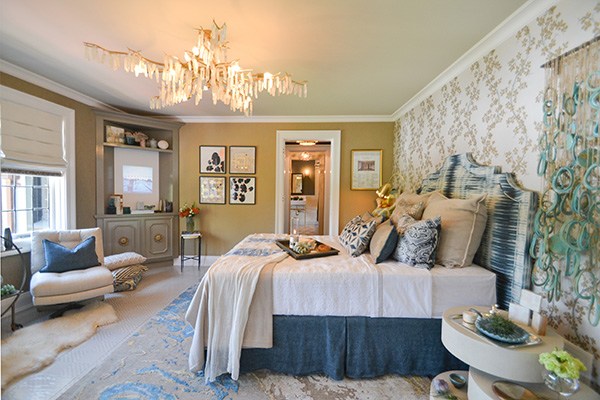
Interior Designer Jeanne Chung’s Guest Bedroom for the 2017 Pasadena Showcase House. Photography by Jeanne Chung.
“When we initially set out to design the Guest Bedroom, we knew that we wanted to incorporate Sony Life Space UX products into the space, as it was the perfect platform to show how seamlessly they could be incorporated into a more traditional space while not detracting from the design of the room, as modern technology often does. We were able to retain much of the home’s original charm and details- original woodwork, window casings and hardware, but now with a modern edge and the addition of modern technological amenities without having to punch through walls to run wiring.” – Jeanne Chung, Owner of Cozy Stylish Chic.
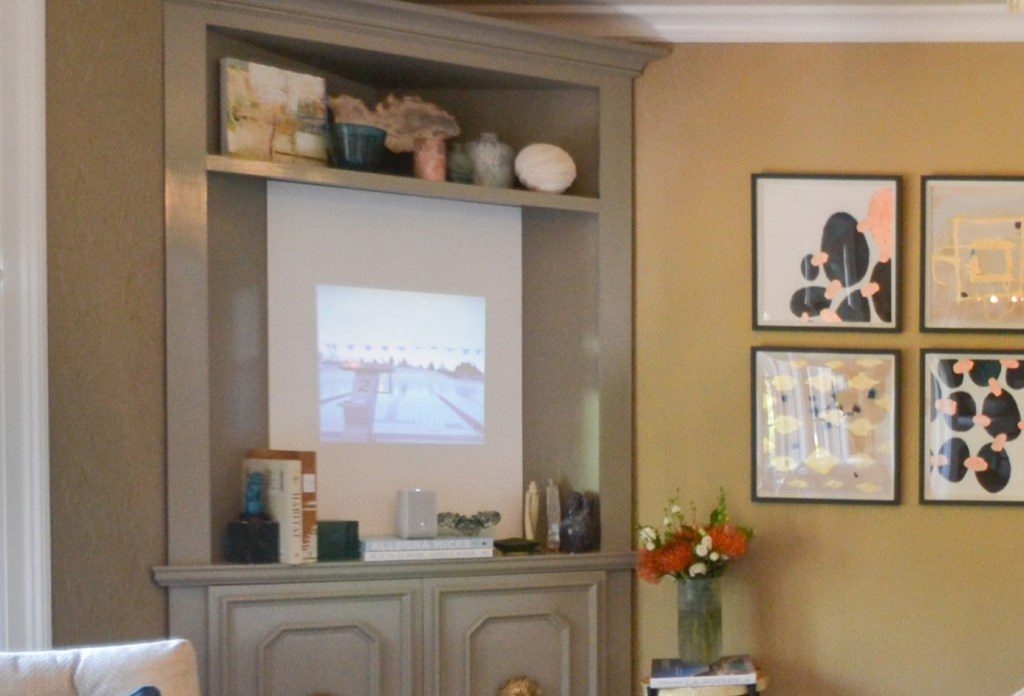
The Sony TV projection on the wall where normally a black wall-mounted TV would be. Imagine, you can watch TV at night or view a home video or family vacation photos, all at the convenience of a SONY projector. Photography by Jeanne Chung.
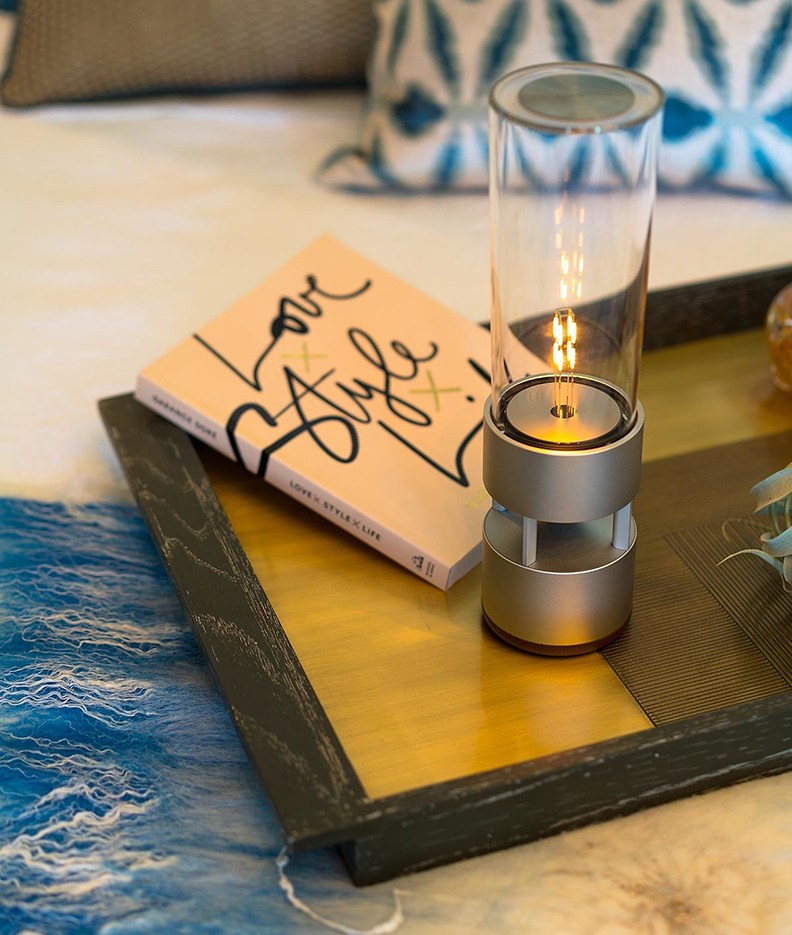
Sony Glass Sound Speaker and LED Filament Bulb. Photography by Minh T Nguyen.
To get the full experience of how Jeanne Chung incorporated the latest Sony technology into the 2017 Pasadena Guest Bedroom, and what each product does, please read excerpts from her blog that Sony posted HERE. Also read Jeanne’s full blog post about her tech-savvy Guest Bedroom HERE which gives you more detail about her vision and how she really wanted to utilize the latest technology. It sure lights the way for more exciting products to be created for our homes!
II. Designing With Lighting Innovation:


Lighting has been forward thinking ever since the LED bulb was introduced, but in the future of design, it seems like lighting has the opportunity to do far more than simply light a room.
According to friend, lighting expert Laura Van Zeyl, Vice President of Lighting Technology & Marketing at the Dallas Market Center, there are a lot of exciting changes ahead:
“I manage the Dallas Market Center’s Lightovation International Lighting Show and two recent speakers represented the future of lighting technology. The main message for both – lighting has the potential to go far beyond illumination.

Beatrice Witzgall
Lighting designer Beatrice Witzgall of LumiFi spoke at the June 2017 edition of Lightovation about lighting’s role in the Internet of Things (IoT). LED technology elevates the level of control that users have on their lighting, from changing light levels to tuning color temperatures (warm or cool for different tasks and moods).
Furthermore, Witzgall explored the emerging opportunities of being able to have that control remotely using a mobile device, which is poised to become the standard. For many, lighting in general is the most logical “on ramp” to connected and smart systems since adopting them can be as simple as changing a light bulb.”
“At the January 2017 edition of Lightovation, Dr. Mariana Figueiro – who was recently named the new Director of the Lighting Research Center at Rensselaer Polytechnic Institute – spoke about the important role lighting plays in human health, including sleep.

Dr. Mariana Figueiro
Dr. Figueiro recommends that lighting manufacturers create products that address the non-visual aspects of light that have profound effects on Circadian rhythms and alertness. But already, with tunable LED lighting, users have the power to made adjustments as needed throughout the day to optimize well-being. In this video from the show, Dr. Figueiro talks about this exciting area in lighting that will only continue to grow.”
I also learned from Laura, that each June edition of Lightovation, attendees vote on their favorite products from the show. Here’s what Laura said specifically for this article about one of the winners:
“One of the six winners for June 2018 was Kichler’s South Hope Portable Bluetooth LED Lantern, which exemplifies a number of technology trends seen worldwide in a single product. This wireless indoor/outdoor lantern can be charged up to provide 5 hours of battery-powered illumination. It can also play music via Bluetooth with a 30-foot range. It’s yet another example of how lighting is going far beyond illumination.”
III. Designing More Efficient Products: From the continuation of cocooning in our luxurious bathrooms to the design of kitchens merging with our living spaces in an open floor format, either way, our homes will continue to reflect our need for social gatherings and the ultimate escape zones.
A third Top 200 Influencers in the Home Design Industry 2017, friend and Kitchen designer/trend expert Susan Serra, CKD, of Susan Serra Associates and founder of Scandinavian Made (gorgeous handmade Swedish rugs!) sums it up quite succinctly when it comes to designing kitchens of the future:
“Kitchen design is and will continue to be a reflection of our society’s values. The concepts of sustainability, healthy eating, social interaction and energy conservation will become even more entrenched in our society and will be translated into the kitchen via aesthetic and functional innovations in:
- appliance design,
- performance materials,
- practical storage solutions, and
- comfortable design solutions.”
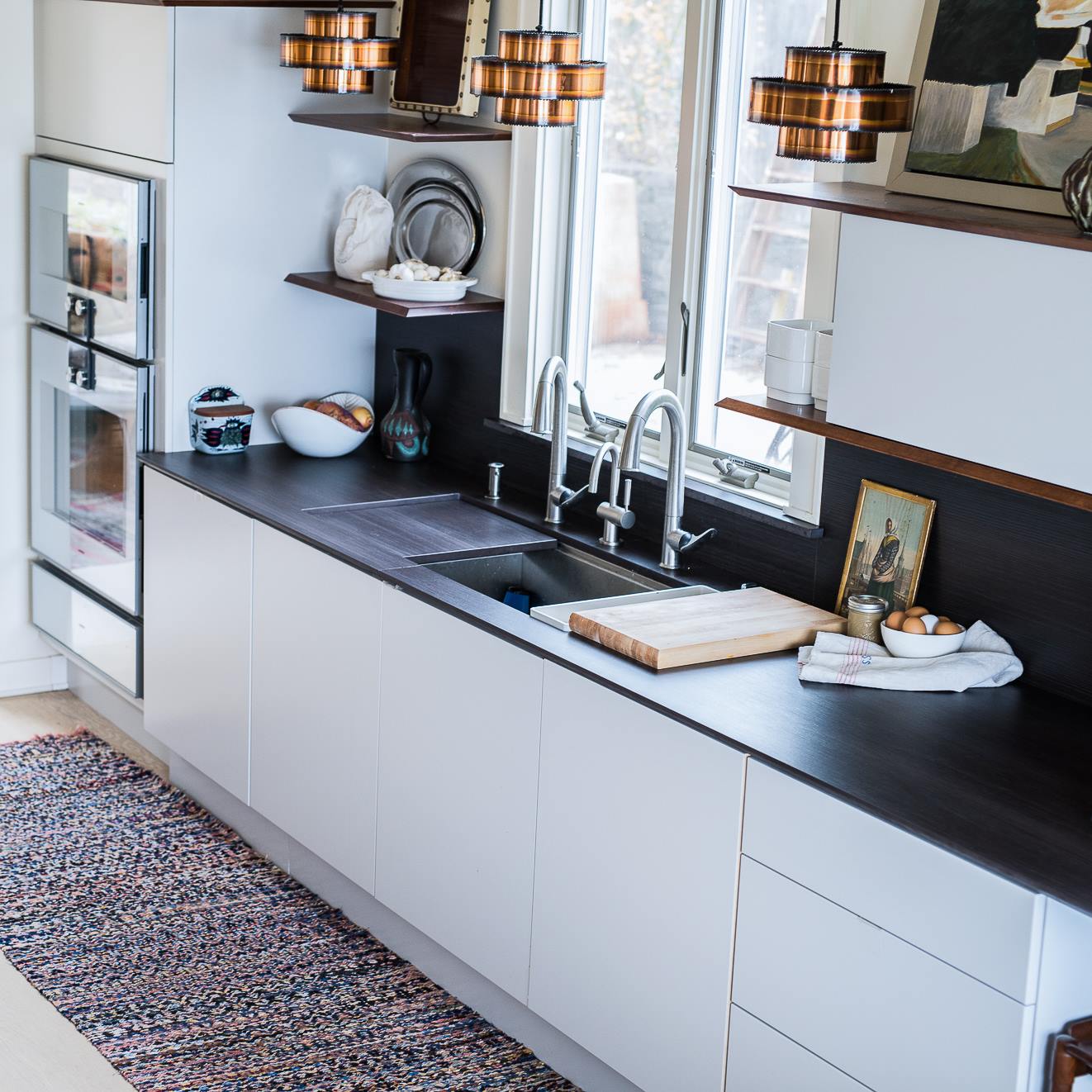
Kitchen designed by Susan Serra incorporating Dekton countertops, Kohler sink/faucets, Gaggenau appliances. Photography by Susan Serra Associates.
I particularly love the simplicity of Susan’s Scandinavian kitchen. Unlike my kitchen, there’s no clutter. Ovens and refrigeration are easy to get to and the sink, faucets and counter tops are streamlined. In our home, we have a cozy breakfast nook, and I think Susan’s is similar in that it often serves as the hub of family and work. Simple design will be in high demand as our population ages and younger generations are more mobile.
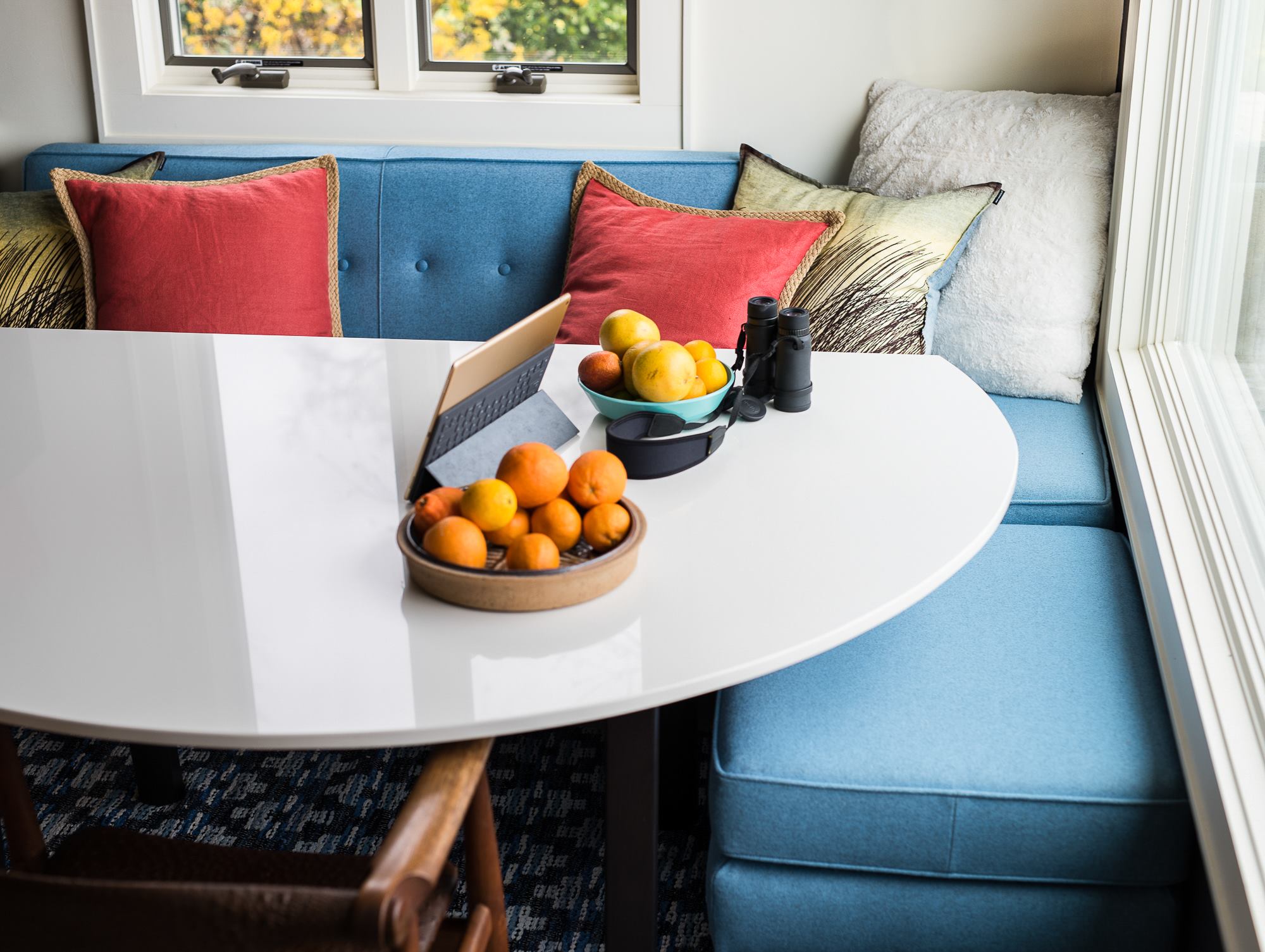
Interior designer and kitchen expert, Susan Serra’s cozy breakfast nook.
 I had the wonderful opportunity, also during the 2014 Modenus NYC Blog Tour, to meet the lovely and talented Canadian interior designer Alison Habermehl, owner of Habermehl Design Group. I also had the privilege of seeing in person the amazing products that luxury brand DXV creates. DXV started that year producing inspiring vignettes by internationally-recognized interior designers as part of the DXV Design Panel. Alison was selected as one of four interior designers for the DXV 2017 Design Panel. I was so impressed with her vision for her contemporary penthouse bathroom that I wanted to ask Alison what she sees as key elements of designing for the future.
I had the wonderful opportunity, also during the 2014 Modenus NYC Blog Tour, to meet the lovely and talented Canadian interior designer Alison Habermehl, owner of Habermehl Design Group. I also had the privilege of seeing in person the amazing products that luxury brand DXV creates. DXV started that year producing inspiring vignettes by internationally-recognized interior designers as part of the DXV Design Panel. Alison was selected as one of four interior designers for the DXV 2017 Design Panel. I was so impressed with her vision for her contemporary penthouse bathroom that I wanted to ask Alison what she sees as key elements of designing for the future.
PG: Congratulations Alison on being selected for the 2017 DXV Design Panel and designing such a gorgeous DXV bathroom. It certainly has inspired me! What were the primary influences in your design?
AH: The city of Toronto itself and a woman were my main influences. We see curves in interesting and contemporary architecture in Toronto and around the world. I wanted to use that in my DXV contemporary penthouse bathroom design. I see homeowners becoming more interested in design overall…looking for a new paradigm to draw from, whether interiors, fashion or marketing. We are also seeing a shift in our thinking about what is masculine and feminine and these lines are becoming blurred.
PG: Yes, consumers are far more savvy now because of the internet. What an important point too – feminine/masculine lines blurring – and how that might affect designing for the future. Tell me about your vision for designing the DXV bathroom? Who is this bathroom for?
AH: In the penthouse suite I designed for DXV, I intentionally designed it for a strong, creative woman by adding the soft blush tones and gold/bronze details. I also specifically designed the function of the room for a woman’s morning and night routines – such as the makeup table/vanity combo. People want to see something new, especially in contemporary and modern design. Depending on how modern or contemporary your style is, curves can be as subtle or bold as you want, but I definitely see a trend toward more curves in future design.
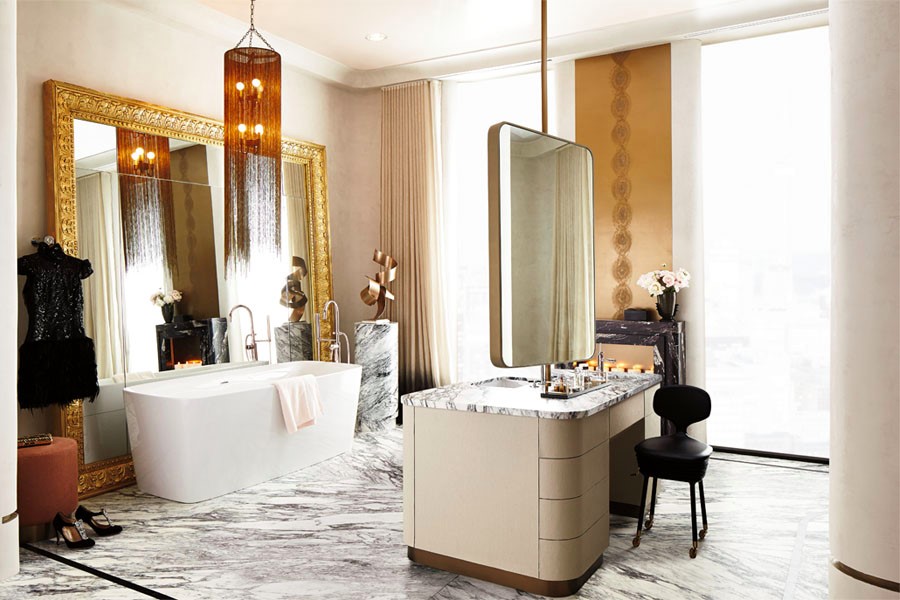
DXV contemporary penthouse bathroom designed by Alison Habermehl. Photography by DXV.
PG: I find that to be a very fascinating design element to bring out. I just never thought about that before. I know I’ll be walking around now noticing the “curves” in architecture and design. Thank you! What else do you think curves bring to the table for designing for the future?
AH: Curves in product design have an organic feel that can be brought into any room. With our world becoming more globally aware and different cultures influencing each other, we see this in both the environmental and cultural aspects. I believe we are influenced by the people we work and socialize with and our wider environment. Those in the creative field who invent all the things we use every day are generally global-minded people who care about different cultures, about the world and our environment. Seeing more curves in our everyday design, is most likely influenced by all this.
PG: Having learned about the DXV luxury brand on our 2014 blog tour we did together, I’ve always loved the high caliber of their products and the commitment to excellence. Tell me what you like about the DXV brand?
AH: DXV uses the right amount of adornment, whether minimal or ornate…the balance is perfect…not too fussy and the minimal detailing isn’t boring because they use the right scale and proportion to keep it interesting. I love contemporary bathroom fixtures, even when designing a more traditional space. I appreciate the simplicity and how it can adapt to all kinds of styles.

Detail of the sink, shower and toilet by DXV in Alison’s contemporary penthouse bathroom. Photography by DXV.
PG: What do you think product designers and interior designers need to take into consideration when designing for the future?
AH: When it comes to designing a bathroom, specifically for a woman, I keep in mind that we generally like both function and beauty equally. Women like things to appeal to all our senses, which has raised the bar for product manufacturers. They have to take this seriously, as woman are the major purchasers. DXV are forerunners in this way of thinking. As much as some people like layers and details in their homes, I find the trend swaying more toward minimal, but technically savvy, products that suit all kinds of decorating styles. For example, the DXV smart toilet not only looks cool, but is seriously functional for both men and woman in different ways.
PG: What major trends and product features do you think we’ll be seeing more of every day in the near and far future?
AH: Multi-functional design happening for many different products. We want things to think for us, like pressing a button that does a function we would normally have to do for ourselves. Demand for more technologically sophisticated functional products that make our busy lives easier . People are becoming more tech savvy and aren’t afraid to use these new, sophisticated products. I think we’re just seeing the beginning of what will be possible.
PG: I not only love your DXV Penthouse bathroom, but I love learning about what inspired and prompted you to design such a luxurious functional bathroom? I think any woman would appreciate your designs! In conclusion, tell me four or five product designs that you think we’ll be seeing more of in the future?
AH: The city of Toronto and a strong woman living there inspired me in my overall design and DXV product selection. These four products are definitely out there for consumers already, but I think we’ll see them emerge more into our everyday products, at affordable prices.
- Self-cleaning/sanitary products.
- Products with a memory. Each person, with his or her own specific needs, has an automatic preference that the product remembers.
- Virtual reality experiences
- Sustainable products. Products being made using entirely sustainable materials or that reverse the toxicity of materials into something usable (like turning garbage into energy power). Products that are only good for one time use that when disposed of will benefit the environment, not harm it.
PG: In your experience what wisdom would you advise new designers for the future?
AH: There needs to be a “human aspect” that appeals to our senses. Products cannot be disconnected from our human senses. They still have to nurture our basic needs to feel, smell, touch and create an emotion. We can’t leave the emotion out of our designs. The human soul is far more complex than any product.
IV. Designing with Greater Customization – My final trend addresses that human aspect that Alison speaks of, as our souls are soothed by color, proportion, luxurious textiles, texture, clean lines, sexy furniture legs, mixing of metal and wood, and more. Like in the above photo of Michelle Workman’s Facet Collection for French Heritage.
But this desire bumps heads with the rapid escalation of pushing the boundaries between offline and online shopping, with less brick and mortar stores, greater number of transactions online, and faster assembly and shipping. This all means better designed and highly efficient products, right? Well, if Amazon is going to be managing all the products we’ll be ordering, who is going to be designing our custom pieces of furniture, luxury pillows, side chair or table?
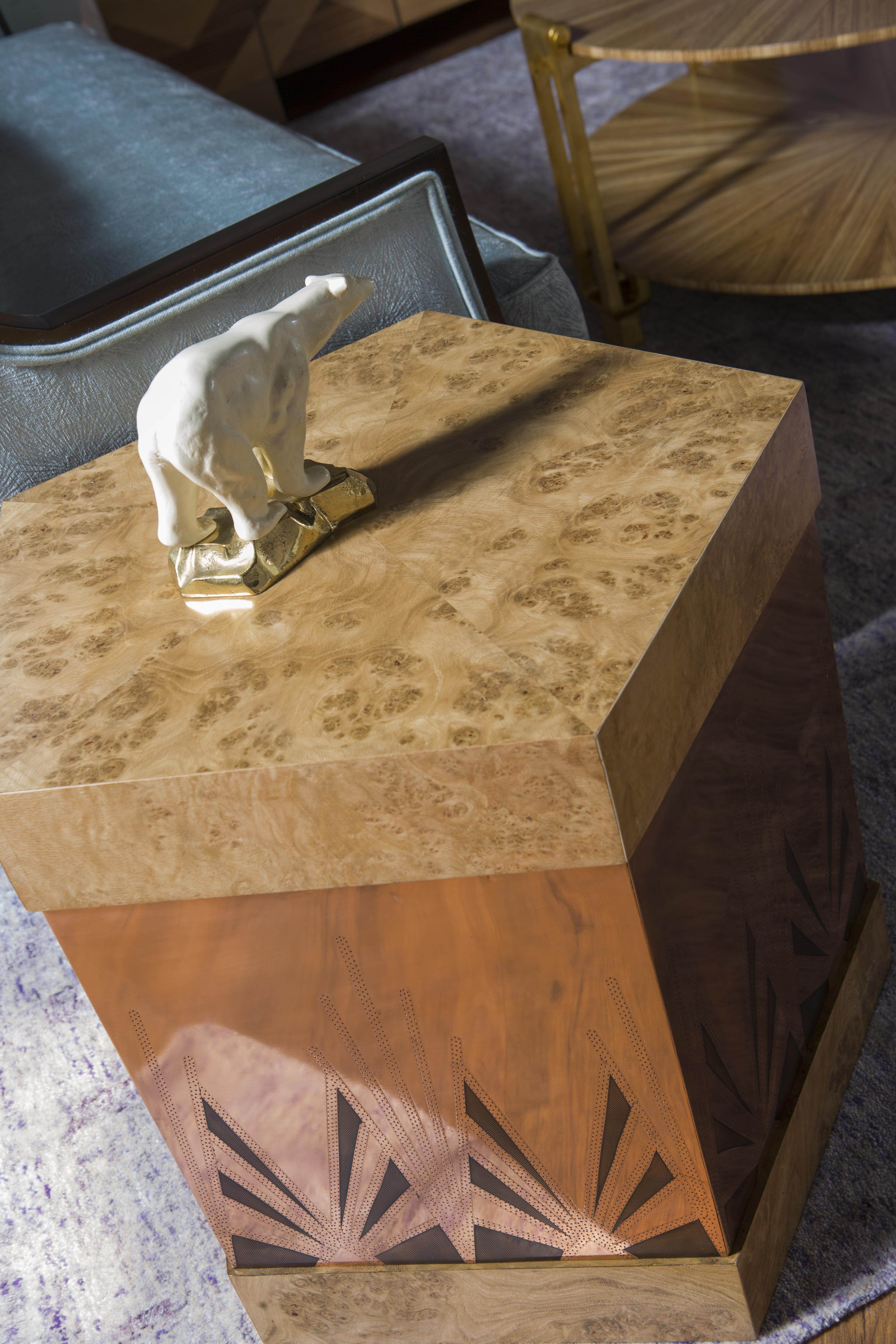
Art Deco Inspired details on side table from the FACET Collection by Michelle Workman for French Heritage. Photography by French Heritage.
Interior Designer Michelle Workman is one of those designers who not only has been customizing furniture for her clients for over 20 years, but has now collaborated with a long-time industry manufacturer, French Heritage, to come up with the most dazzling Art Deco- inspired line of furnishings, the FACET Collection.
 I was delighted to recently meet Michelle and the owner of French Heritage, Henessy Wayser, at Dallas Market in June. Please check out my blog post HERE. So I can attest to her insightful new FACET Collection and the trends she mentions below. Bring on the exotic wood and petite furnishings!
I was delighted to recently meet Michelle and the owner of French Heritage, Henessy Wayser, at Dallas Market in June. Please check out my blog post HERE. So I can attest to her insightful new FACET Collection and the trends she mentions below. Bring on the exotic wood and petite furnishings!
Michelle has seen a “Big turn towards Art Deco and customization”, predicting that we’ll be seeing more and more of this trend in the coming years. Below are a few of the current trends that Michelle sees in the materials used in designing furniture for the future.
- Pairing of manmade materials with organic,
- Use of exotics, more shagreen, more alligator and snake, parchment, etc.,
- Exotic woods, like burl and zebra, all elements that were used heavily in the Art Deco period,
- Scaling down of furniture has started and will continue for the next generation,
- The millennial generation is looking for sustainability, not just in resources but in scale and lifestyle,
- Smaller more appropriately human-scaled furnishings will be de riguer for this generation and into the next.
- Highland House is leading the charge with their market introductions for the last two years with beautifully proportioned and elegantly scaled upholstery pieces.
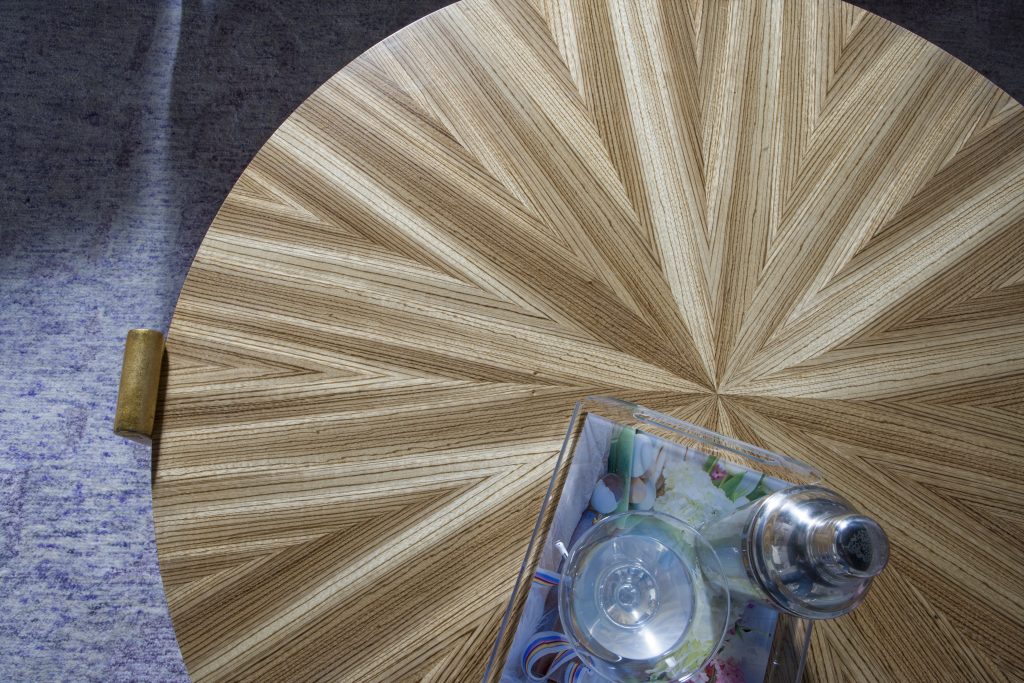
Detail of exotic wood finish on Michelle Workman’s coffee table in the FACET Collection for French Heritage. Photography by French Heritage.
“I have long been a proponent of elegantly scaled furnishings and so, when designing my FACET Collection for French Heritage I pushed this agenda with our pieces, which are more proportioned to a smaller scale and have an understated elegance to their line and proportion.”
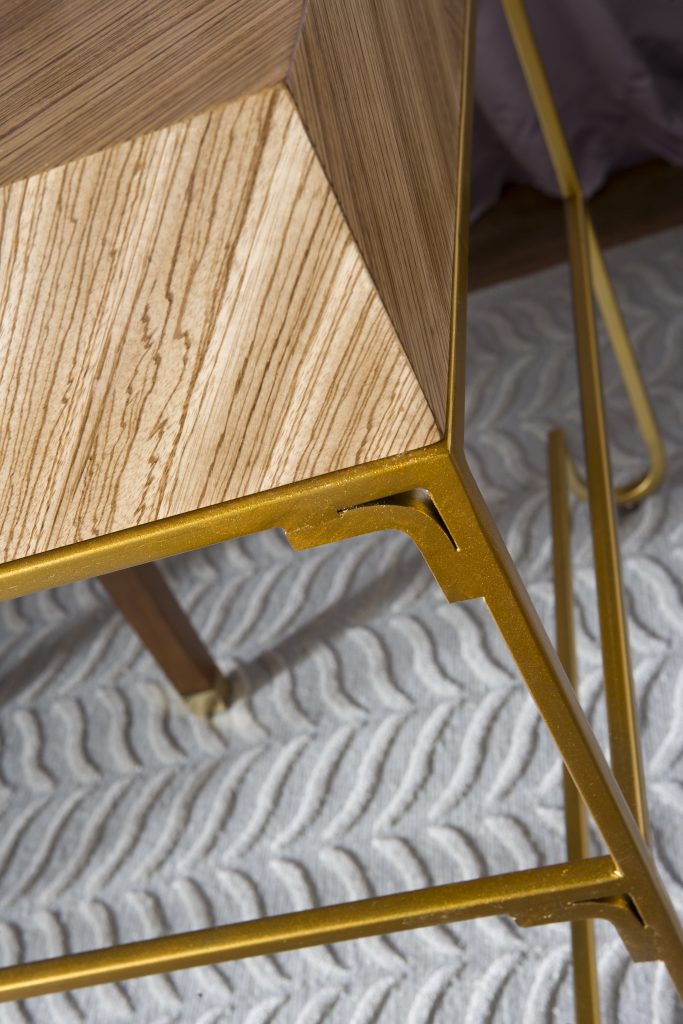
Michelle Workman detail of side table for French Heritage. Photography by French Heritage.
 Long-time friend and luxury interior designer, Patrick Landrum, of PL& D/Patrick Landrum Design, also sees customization as a continuing influence in the future of design:
Long-time friend and luxury interior designer, Patrick Landrum, of PL& D/Patrick Landrum Design, also sees customization as a continuing influence in the future of design:
“The rise of the internet as well as other mediums have definitely increased the level of sophistication of the average person….however conversely, it has also made mediocrity in design more palatable as well as more widely available. Mediocrity goes against human nature, it’s a bore. This boredom will drive the consumer to search out more exotic, custom pieces. Not only personalized, but truly custom designed and made for them alone.”
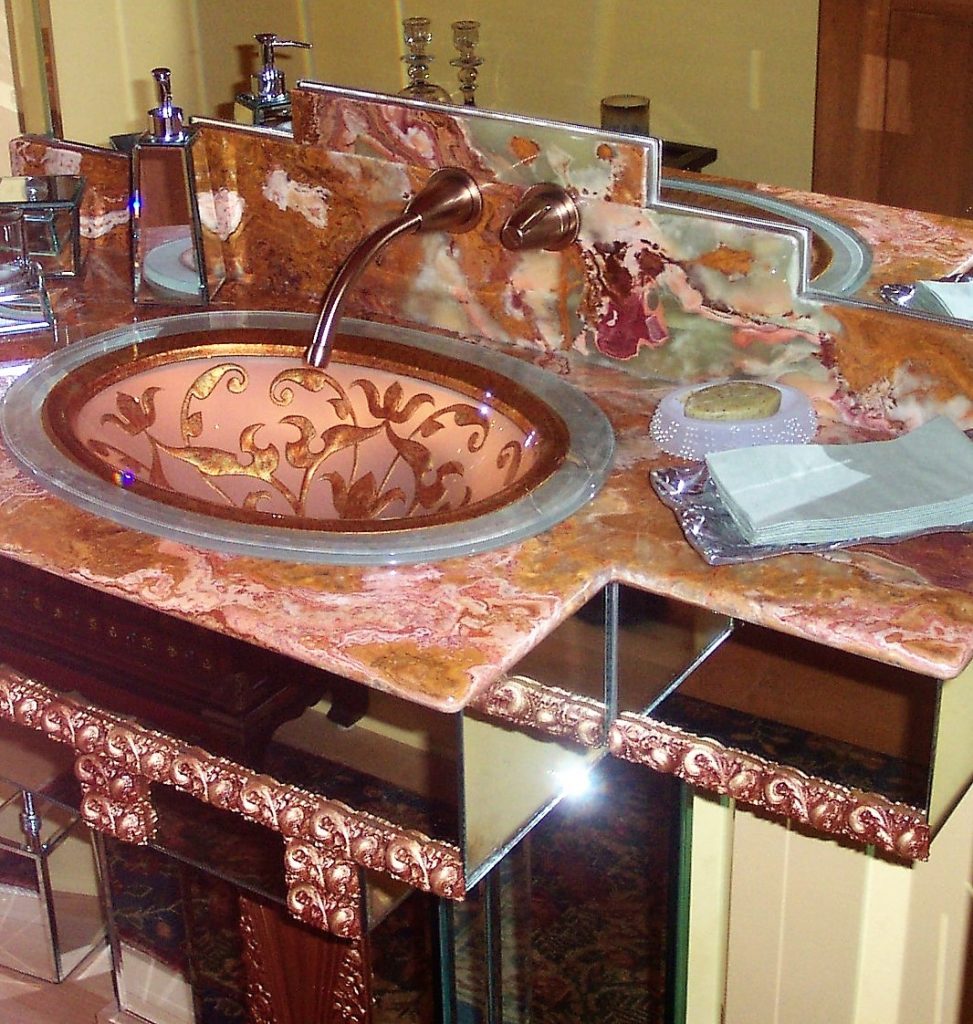
This is a “set up” photo of a vanity in the 1920’s Deco theater style customized and made for a client by interior designer Patrick Landrum. Photography by Patrick Landrum.
The Art Deco-inspired sink bowl above is:
“frosted using cut Venetian glass with gold leafing. The jade onyx slab and accents are lit from beneath, inside the fully mirrored vanity itself, so the counter-top lights up as well as the glass bowl. This is an example of extreme customization which is what people will be wanting more and more of as they become bored with what’s common and everyone else has.”
Patrick, like Michelle, also sees the following Art Deco characteristics becoming more appealing to consumers looking for something different that truly reflects their individuality:
- Greater attention to detail in every fact of design,
- Exotic woods like Macasscar Ebony, Zebra, Burl
- Delicate and detailed multi-type metal work, and
- Tufting and sleek sexy silhouettes.
The four “Designing for the Future” trends I highlight in this article all overlap, are interconnected and integral to the fabric of our life and the rapid changes in customization and technology that we’ll experience in our world. We are far more connected with one another than ever before. The internet has almost made our world borderless. I can only imagine the incredible design innovations that will occur in the next 10-20 years!
Yet, in this discussion of the future of design, I’d like to pose a few final questions:
- How does increasing comfort in our private spaces connect us to our community’s public spaces?
- Isn’t the design of our public spaces in some ways equally, if not more, important?
- We don’t want to close ourselves off completely within our homes with all of life’s luxuries and technological conveniences, do we?
The challenges of the next 20 years in the future of design involve not only how to live our lives with independence, but how to remain integrated as a society and thrive in an interconnected world. Think of all of our senses – taste, sight, touch, smell, hearing – all that makes us one humanity and gives us the need to connect, not just to the latest technology, but to each other. This is something I feel is very important to also consider when designing for the future.
With “56% of the world’s population over 60” by 2030, one of my hopes and visions for the future of design is to see intergenerational communities designed for the young and old to live together, helping one another. They have them in Europe and hopefully the USA will follow suit.
I hope you’ve enjoyed my four trends, but most particularly the trend analysis by these wonderful and knowledgeable experts in the home design industry. I have come to truly value their friendship, advice and guidance in design. I hope you will too. Till next time, get out there and connect with humans AND technology. Perhaps you will be the next person to design something unique for our future. XO PG
Note: This blog post is a part of the Design Blogger Competition organized by CGTrader. This is not a sponsored post by any of the people or brands mentioned. All opinions are my own except for the quotations and interviews of my seven guest design and trend experts. I’d like to thank each guest – Leslie Carothers, Jeanne Chung, Laura Van Zeyl, Susan Serra, Alison Habermahl, Michelle Workman and Patrick Landrum – for their insightful, educational comments and assistance in this blog post. All photos are provided, and used with permission, by the individuals quoted in this post.




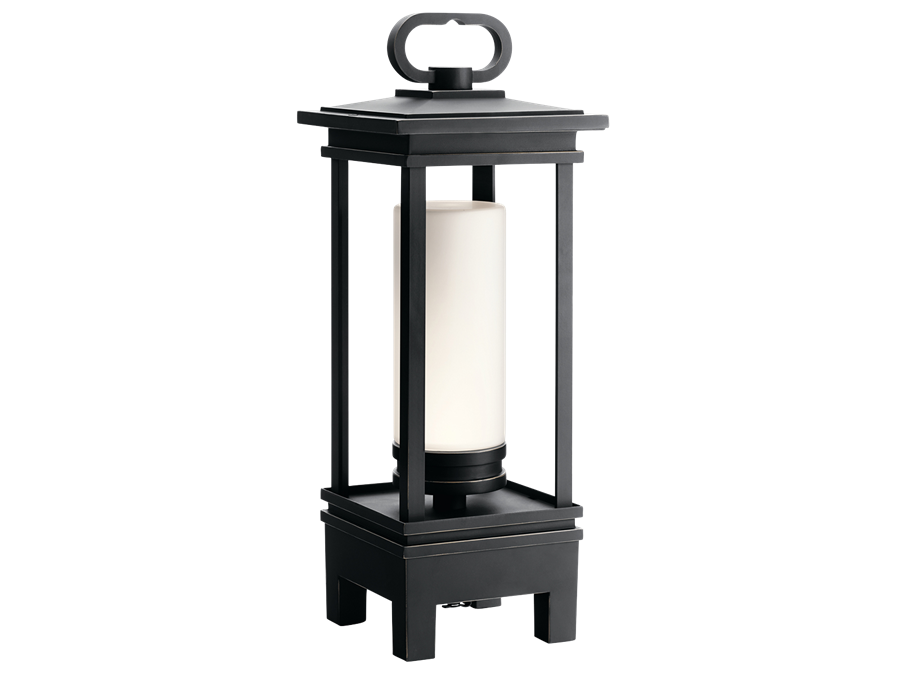

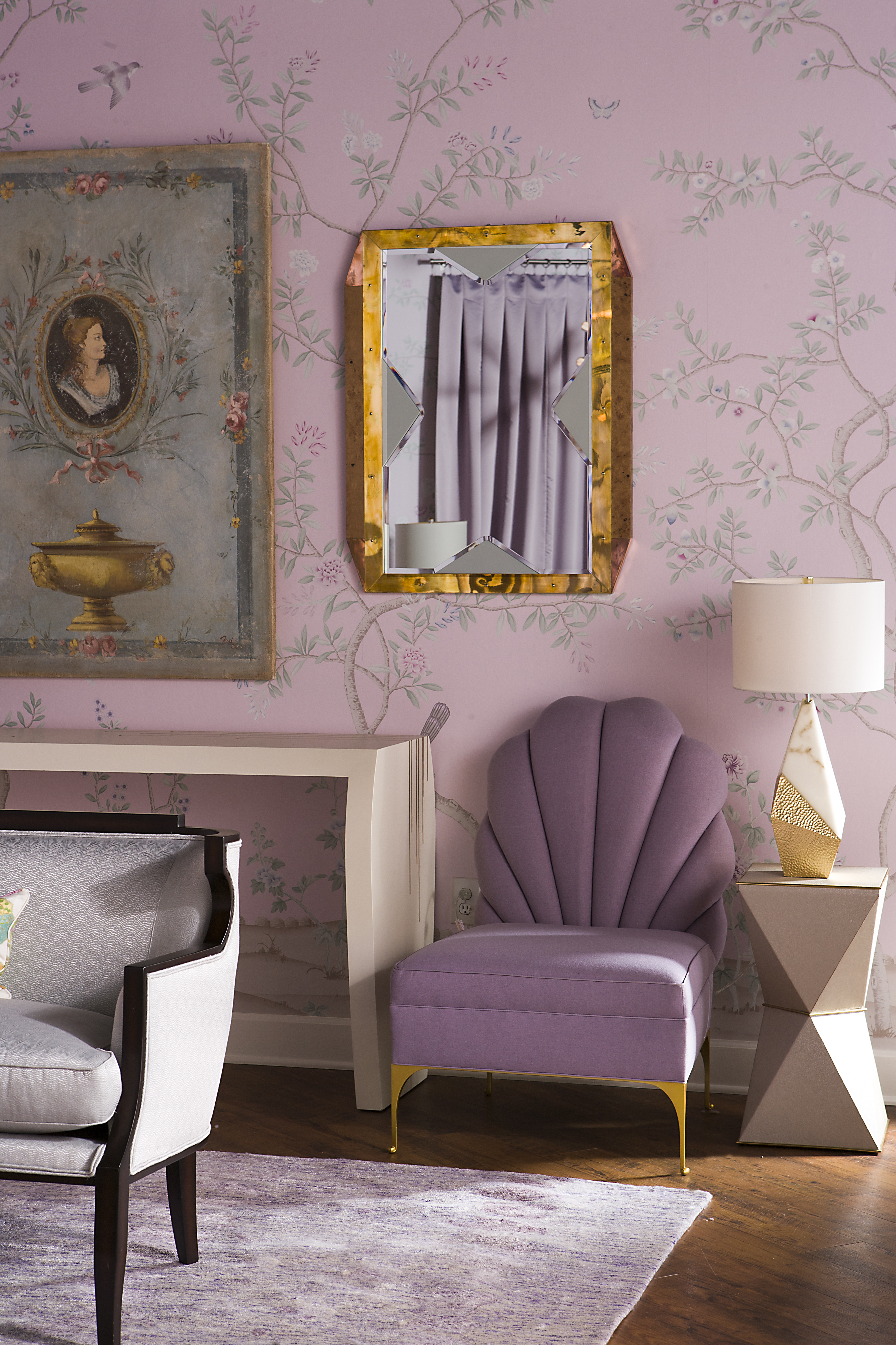

Bhanwarlalji
Posted at 07:34h, 28 NovemberThat’s a fantastic list of resources for interiors. This really helps to find perfect interiors for interior design service provider. Thanks for sharing some really great things here.
I have also found a great interior designers site Interior Designers .
Thank you
Deborah Main
Posted at 17:33h, 22 DecemberThank you for your kind comments and my apologies for just seeing this now. It was a very busy fall. Yes, although a long blog post, its an excellent resource of design experts in the design industry. And not sure if you know, but it won 2nd prize in the “Designing for the Future” blogging contest. Thank you too for sharing your website. Very nice! Happy Holidays!